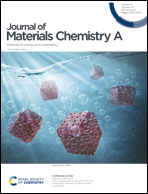The effect of an anode functional layer on the steam electrolysis performances of protonic solid oxide cells†
Abstract
Protonic solid oxide steam electrolysis cells (P-SOECs) based on BaZrxCe0.8−xYb0.1Y0.1O3−δ proton conductors are promising to produce “green” hydrogen from renewable energy at intermediate temperatures. Herein, we demonstrate that the electrolysis performances of a cell with a high-Zr-content electrolyte, BaZr0.6Ce0.2Y0.1Yb0.1O3−δ (BZCYYb6211), can be significantly improved by using a La0.5Sr0.5CoO3−δ (LSC) thin film (∼90 nm) as an anode functional layer (AFL). Electrochemical measurements indicated that LSC-AFL significantly reduced the barrier height for the electrochemical proton incorporation reaction at the gas–electrolyte–electrode triple-phase boundary. Hence, both the ohmic and polarization resistances of the BZCYYb6211 cell decreased from 0.52 and 0.98 Ω cm2 to 0.26 and 0.57 Ω cm2, respectively, with the LSC-AFL at 600 °C. In addition, the BZCYYb6211 cell achieved a high electrolysis current of 1.22 A cm−2 at 1.3 V with a Faraday efficiency of approximately 80%, which was equivalent to that (1.13 A cm−2) of the cell with a state-of-the-art electrolyte BaZr0.1Ce0.7Y0.1Yb0.1O3−δ (BZCYYb1711). BZCYYb6211 with LSC-AFL showed good durability at 500 °C under high steam conditions with an applied current of 1 A cm−2 for 100 h. These results revealed that the introduction of an AFL is an effective method to obtain P-SOECs with excellent performances and durability.



 Please wait while we load your content...
Please wait while we load your content...
